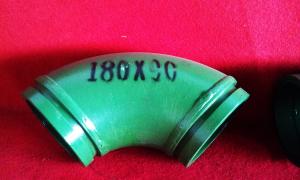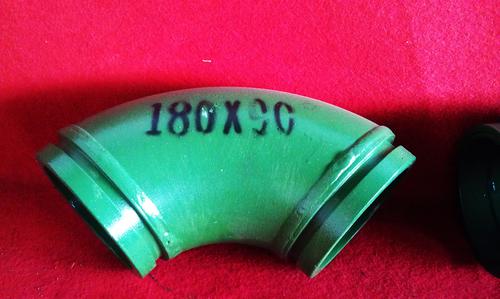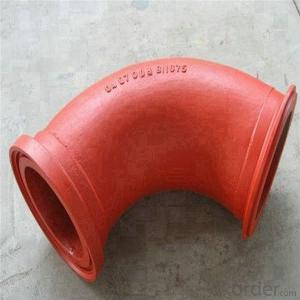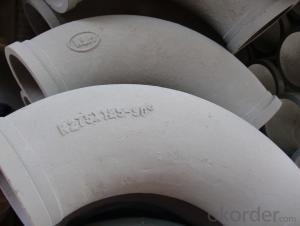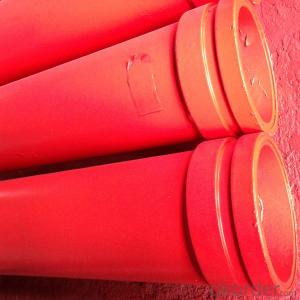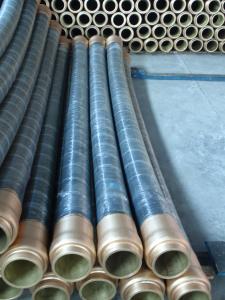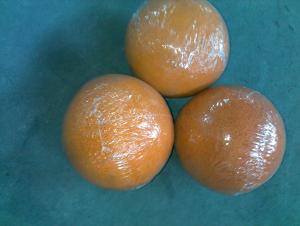Concrete Pump Elbow Pipeline
- Loading Port:
- China Main Port
- Payment Terms:
- TT OR LC
- Min Order Qty:
- -
- Supply Capability:
- -
OKorder Service Pledge
Quality Product, Order Online Tracking, Timely Delivery
OKorder Financial Service
Credit Rating, Credit Services, Credit Purchasing
You Might Also Like
Elbow DN125*R275*90
Elbow DN125*R275*45
Elbow DN125*R275*30
Elbow DN125*R275*25
Elbow DN125*R275*15
Elbow DN125*R500*90
Elbow DN125*R500*45
Elbow DN125*R500*30
Elbow DN150*R500*90
Elbow DN125*R1000*90
Elbow DN125*R1000*90, Schwing ends
Elbow DN125*R350*90, T:4.5mm
Other sizes, please contact with us!!!
- Q: What is the function of a concrete pump hopper grate lever?
- The concrete pump hopper grate lever serves the purpose of regulating the opening and closing of the hopper grate on a concrete pump. The hopper grate, which is a metal grid covering the chamber where the concrete is loaded before being pumped, is controlled by this lever. This lever grants the operator the ability to effortlessly adjust the position of the grate. It can be opened to allow the concrete to flow into the hopper or closed to prevent any debris or foreign objects from entering the pump system. The control provided by the lever is essential for ensuring the smooth and efficient operation of the concrete pump. Any obstructions or contaminants in the hopper have the potential to cause damage to the pump or compromise the quality of the concrete being pumped. By utilizing the hopper grate lever, the operator can maintain a constant flow of concrete into the pump and ensure that only clean and properly mixed concrete is used. Moreover, the lever serves as a safety precaution, allowing the operator to swiftly close the grate in the event of an emergency or malfunction. In conclusion, the concrete pump hopper grate lever plays a critical role in the effective functioning and upkeep of a concrete pump system.
- Q: Can I get spare parts for concrete pump hydraulic cylinders and valves?
- Yes, spare parts for concrete pump hydraulic cylinders and valves are generally available. It is recommended to contact the manufacturer or a reputable supplier to inquire about the specific parts you need for your concrete pump.
- Q: What is the purpose of a concrete pump electric motor?
- The purpose of a concrete pump electric motor is to provide the necessary power and torque to pump concrete from one location to another, eliminating the need for manual labor and increasing efficiency in construction projects.
- Q: Can concrete pump spare parts be heat-treated or hardened for increased durability?
- Yes, concrete pump spare parts can be heat-treated or hardened for increased durability. Heat treatment involves subjecting the parts to controlled heating and cooling processes to alter their mechanical properties. This can significantly improve their hardness, strength, and wear resistance, making them more durable and capable of withstanding harsh operating conditions. Heat treatment methods such as quenching and tempering, induction hardening, and case hardening can be applied to different types of spare parts, including cylinders, pistons, wear plates, and delivery pipes. These processes help to enhance the overall performance and lifespan of the spare parts, ensuring they can withstand the demanding nature of concrete pumping operations.
- Q: How often should concrete pump control boxes be inspected and replaced?
- Concrete pump control boxes should be inspected regularly to ensure proper functioning and safety. The frequency of inspections and replacements will depend on various factors including the usage of the concrete pump, the operating conditions, and the manufacturer's recommendations. In general, it is advisable to inspect the control box at least once a year or as per the manufacturer's guidelines. However, if the concrete pump is used extensively or subjected to harsh operating conditions, more frequent inspections may be necessary. This includes inspecting the electrical connections, switches, buttons, and indicators for any signs of wear, damage, or malfunction. Additionally, it is important to conduct inspections after any significant maintenance or repair work on the concrete pump, as well as after any incidents or accidents. Regular inspections help identify any potential issues early on, allowing for timely repairs or replacements, thereby minimizing the risk of breakdowns or accidents. As for replacements, control boxes should be replaced if they are damaged beyond repair or if they are outdated and no longer meet safety standards. It is important to consult the manufacturer or a qualified professional to determine the appropriate replacement schedule based on the specific conditions and usage of the concrete pump. Remember, regular inspections and timely replacements of concrete pump control boxes are crucial to ensure the safe and efficient operation of the equipment.
- Q: How can one determine the correct viscosity and temperature range for lubricants used in concrete pump spare parts?
- Determining the appropriate viscosity and temperature range for lubricants used in concrete pump spare parts requires the consideration of multiple factors. Below are some steps that can assist in determining the suitable viscosity and temperature range: 1. Refer to the manufacturer's recommendations: To begin with, consult the specific guidelines or recommendations provided by the manufacturer for the concrete pump spare parts. The manufacturer may specify the required viscosity and temperature range for the lubricants used in their equipment. 2. Gain a clear understanding of the operating conditions: It is essential to have a comprehensive understanding of the operating conditions in which the concrete pump spare parts will be utilized. Factors such as ambient temperature, pump speed, load, and pressure should be taken into account. These factors can significantly impact the viscosity requirements and temperature range of the lubricant. 3. Assess the performance characteristics of the lubricant: Different lubricants possess distinct performance characteristics that make them suitable for particular applications. Look for lubricants specifically formulated for heavy-duty tasks, offering excellent wear protection and displaying good thermal stability. These performance characteristics ensure that the lubricant can endure the demanding conditions of a concrete pump. 4. Viscosity requirements: The viscosity of the lubricant plays a crucial role in ensuring proper lubrication and safeguarding of the concrete pump spare parts. Heavy-duty applications generally require higher viscosity lubricants, while lighter loads may be better suited with lower viscosity lubricants. The viscosity requirements may also differ depending on the specific pump parts, such as bearings, gears, or seals. Referring to the manufacturer's guidelines and seeking advice from lubricant suppliers can help determine the ideal viscosity range for the concrete pump spare parts. 5. Consider the temperature range: The temperature range within which the concrete pump operates is another significant aspect to consider. Lubricants should be capable of maintaining their viscosity and performance across the expected temperature range. Extreme temperatures can cause lubricants to lose their effectiveness, potentially leading to equipment damage or failure. Consequently, it is important to select lubricants with a temperature range suitable for the operating conditions of the concrete pump. 6. Consult with experts: If uncertainty persists regarding the appropriate viscosity and temperature range, it is advisable to seek advice from lubricant manufacturers, suppliers, or industry experts. They can offer valuable insights and recommendations based on their expertise and experience with concrete pump spare parts. By adhering to the manufacturer's recommendations, comprehending the operating conditions, evaluating the lubricant's performance characteristics, and seeking professional advice, it becomes possible to determine the correct viscosity and temperature range for lubricants used in concrete pump spare parts. This will ensure optimal lubrication and extend the lifespan of the equipment.
- Q: How often should a hopper filter be cleaned or replaced?
- The cleaning or replacement frequency of a hopper filter relies on various factors such as hopper type, contaminant nature, and usage pattern. It is generally suggested to clean or replace the hopper filter every three to six months. However, if the hopper operates in a dusty or dirty environment, or deals with materials generating abundant debris, more frequent cleaning or replacement might be necessary. Regular examination of the hopper filter is vital to assess particle accumulation and filtration efficiency. Additionally, if the hopper filter displays signs of damage or wear, immediate replacement is essential to maintain peak performance and prevent potential contamination. Ultimately, it is advisable to consult the manufacturer's guidelines and recommendations for the specific hopper filter in use.
- Q: What is the function of a concrete pump control valve?
- The function of a concrete pump control valve is to regulate the flow of concrete from the pump to the desired location. It allows the operator to control the speed and direction of the concrete flow, ensuring the precise placement of the concrete. The control valve also helps in preventing any blockages or clogs in the pumping system by allowing the operator to adjust the pressure and flow rate of the concrete. Additionally, the control valve helps in maintaining the safety of the operation by providing the operator with the ability to stop or start the concrete flow as needed. Overall, the concrete pump control valve plays a crucial role in efficiently and effectively transferring concrete from the pump to the desired location.
- Q: How do I maintain the performance of concrete pump spare parts in extreme weather conditions?
- To maintain the performance of concrete pump spare parts in extreme weather conditions, it is crucial to take certain precautions. Firstly, ensure that the spare parts are properly protected from direct exposure to harsh weather elements such as rain, snow, or extreme heat. This can be achieved by using covers or shelters to shield the parts. Additionally, regular cleaning and lubrication of the spare parts will help to prevent any buildup of dust, dirt, or moisture that could potentially affect their performance. Lastly, conducting regular inspections and maintenance checks will allow for early detection of any damage or wear, enabling timely repairs or replacements to be made, thus ensuring optimal performance in extreme weather conditions.
- Q: Are there any warranties or guarantees on concrete pump spare parts?
- Yes, there are warranties and guarantees offered on concrete pump spare parts. Many manufacturers and suppliers provide warranties on their products to ensure the quality and performance of the spare parts. These warranties may vary in duration and coverage depending on the specific supplier or manufacturer. It is important to check with the supplier or manufacturer to understand the terms and conditions of the warranty or guarantee before purchasing the concrete pump spare parts. Additionally, some suppliers may also offer extended warranties or guarantees for an additional cost, providing further peace of mind to the customers.
Send your message to us
Concrete Pump Elbow Pipeline
- Loading Port:
- China Main Port
- Payment Terms:
- TT OR LC
- Min Order Qty:
- -
- Supply Capability:
- -
OKorder Service Pledge
Quality Product, Order Online Tracking, Timely Delivery
OKorder Financial Service
Credit Rating, Credit Services, Credit Purchasing
Similar products
Hot products
Hot Searches
Related keywords
